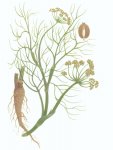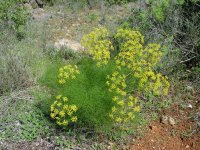Fennel common
Foeniculum vulgare Mill.
Botanical characteristics. Family umbrella. Annual herbaceous plant with a straight cylindrical stem, naked below and branched at the top, with height up to 40-80 cm. Has a thin, spindle-shaped root. The leaves are partitioned, with linear filiform lobes. Yellow small flowers are collected on the tip of the stem in the inflorescence umbrellas. Blossoms in June-July. Seeds ripen in July-August. The whole plant has a strong pleasant spicy smell.
Spread. The birthplace of fennel is Persia and India. In the wild, it occurs in the European part of Russia, the Urals, the Caucasus, the Baltic and Central Asia. It grows near habitation. As a spicy and medicinal plant is bred in gardens and orchards.
Used parts of the plant.
Fruit.
Fennel fruits contain essential oil (2-6%), protein substances (up to 20%), fatty oils (up to 18%), sugar (up to 5%). Essential oil consists of anethole, fenchone, anisic acid, anisaldehyde, anisic ketone, pinene, methylhavicol, fellandrene, limonene and dipentene.
Application.
With a therapeutic purpose it is used to improve digestion, as a carminative, with spasms of the stomach and intestines, dyspepsia, and also to strengthen lactation, as an expectorant for respiratory diseases.
Fennel fruits are part of breast, choleretic, carminative and sedative.
They are used as an aromatic seasoning in the preparation of vegetable and meat dishes, pickling mushrooms and cucumbers, in the confectionery industry and in perfumery.
Preparation.
Infusion: 2 teaspoons of fruit insist with 200.0 g of boiling water (in a thermos) - daily dose.
Pharmacies sell fennel preparations. Fennel oil is prescribed for flatulence and as an expectorant (5-10 drops per reception); Dill water is prescribed inside 1 tablespoon 3-6 times a day. Collection of carminative consists of equal parts of fennel, peppermint and valerian. Take with flatulence. One tablespoon of the collection is insisted in a 0.5-liter thermos - a daily dose.




Comments
Commenting on, remember that the content and tone of your message can hurt the feelings of real people, show respect and tolerance to your interlocutors even if you do not share their opinion, your behavior in the conditions of freedom of expression and anonymity provided by the Internet, changes Not only virtual, but also the real world. All comments are hidden from the index, spam is controlled.